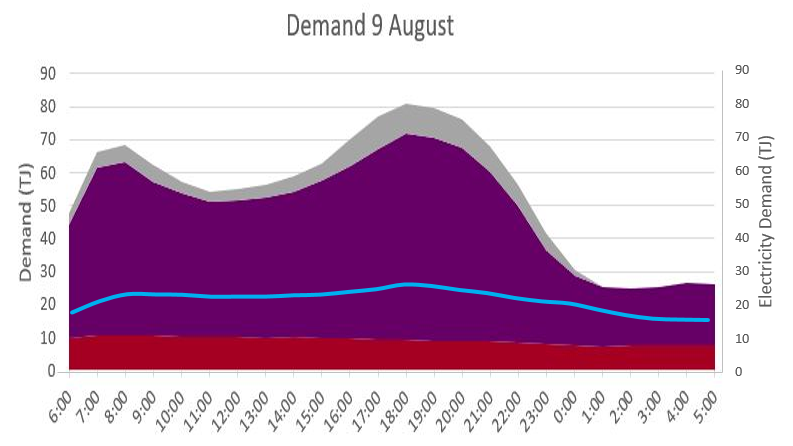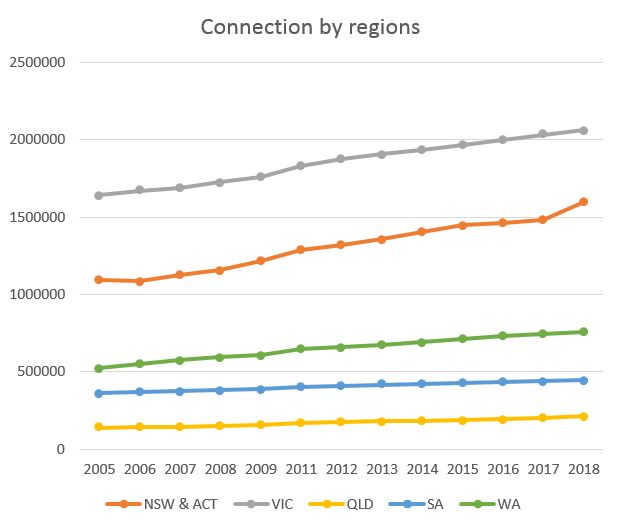No moratorium on gas demand
With all the hype about rising wholesale gas prices, gas demand levels are probably falling right? Wrong.
Mt Gas – a new peak
Friday 9 August was one of the coldest days in Melbourne this year. The minimum of six degrees wasn’t the main concern, it was the maximum of just ten – quite a few degrees below the monthly average.
AEMO’s published gas demand for the day reported the highest ever level for Victoria, with a total of 1,304 Terajoules (TJ) breaking the record set on 17 July 2007. The chart below illustrates industrial demand (in red), household and commercial demand (in purple) and demand for gas-fired power generation (grey). The electricity demand for that day (blue line) is also shown below.

Figure 1: Victorian gas and electricity[1] demand for 9 August 2019 (Source: AEMO data, Energy Networks Australia analysis).
Some observations about gas use on this day:
- Gas demand peaks firstly between 7 am and 8 am in the morning and then between 5 pm and 8 pm at night. This reflects the use of energy consumption by homes and businesses with high levels of space heating during these times as people prepare to go to work or come home in the evenings and heat their homes.
- The peak electricity demand occurs at the same time.
- Gas provides three times as much energy as electricity during these peak periods.
- While there is much coverage of industrial gas use, especially by Victorian manufacturers, household and commercial demand was by far the biggest contributor to the record peak demand.
- Gas is also used to produce electricity with the most gas generation occurring during the evening peak.
The daily use of gas in winter illustrates the flexibility of the gas supply system. This system can store gas[2] and provide it at times when it is needed. It also shows how gas is complementary to electricity networks. While gas demand for industry is relatively uniform throughout the year, the gas demand in summer for households only includes hot water and cooking. Overall, summer demand for gas is around one-third of that for winter.
There are some proponents pushing the electrification of the gas load. Clearly, this is not practical given gas networks provide three times as much energy as electricity networks. The amount of additional investment in the electricity network to effectively duplicate the energy transported in the gas network would be massive – and the costs ultimately borne by customers and the broader economy.
The other two supporting arguments for electrification (linking with rooftop solar and high efficiency of appliances) also don’t make sense on cold winter days. As can be seen from Figure 1, the peak heating demand occurs early in the morning or during the evening – both times when rooftop PV is not generating. Heat pump proponents also claim high efficiencies of 400 to 500 per cent, but this is not reflective of the actual operation of these heat pumps at lower temperatures. As noted in the New Zealand Good Practice Guide – Heat Pump Installation (2019):
As the difference between outdoor temperature and desired indoor temperature increases, the efficiency of a heat pump system decreases[3].
What this means is that the claimed efficiencies are often overstated. The result is that installations based on the design efficiencies may not perform very well in the depths of winter, leaving consumers in the cold.
Growing connection
The peak in gas use is partly due to the growing number of connections to the gas network. Victoria made its two millionth connection to the gas network in late 2016 and it is still growing. On average, an extra 38,000 homes and businesses a year have connected to gas networks in Victoria over the past five years. Assuming two adults in each home, that is about 76,000 more people a year with an interest in gas. From consumer feedback, we know that affordability and sustainability are key issues so being able to access gas – at reasonable prices – and ensuring that this gas is a clean energy option is important to Victorians.

Figure 2: Connections to gas networks in Australia (Source: Energy Networks Australia analysis).
Summer demand
During summer, gas demand in households reduces by more than two thirds, leaving significant capacity in the network to meet other gas demands. Normally, Australia’s gas exports from Queensland increase over our summer to meet the demand for heating in the northern hemisphere and some gas is redirected to replenish gas storage sites.
This year, however, AEMO has indicated possible electricity shortages for Victoria during summer as a result of the ongoing repairs of Loy Yang A2 and Mortlake. This could result in a shortfall of between 125 MW and 560 MW during summer months, especially on those hot summer days where air conditioners are necessary. Interestingly, if we see a greater uptake of gas-powered air conditioners, gas networks will be able to provide some of this peak summer energy demand.
Gas supply
So, what does this all mean for customers? With growing gas connections in the market, increasing new peaks of gas use and possible electricity shortages this summer, gas remains a critically important source of energy for Victorians.
Yet, the Victorian Government maintains a moratorium on onshore exploration and development of new gas supply. To be clear, lifting this moratorium will not provide new gas by this summer, but additional sources of supply will put downward pressure on prices in the longer term. Lifting this moratorium and actively engaging in decarbonising the gas sector (through supporting renewable gas technologies) will help the two million-plus households and businesses in Victoria continue to access affordable and sustainable energy through their gas network.
References
[1] Electricity has been converted from MWh to TJ.
[2] See earlier Energy Insider pieces: https://www.energynetworks.com.au/news/energy-insider/energy-storage-we-can-be-happy-underground/



